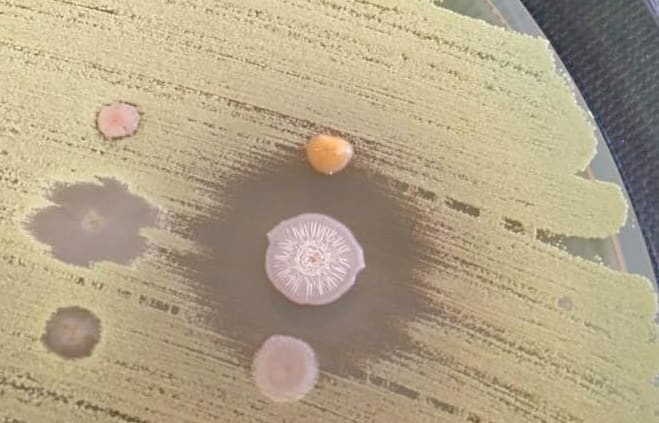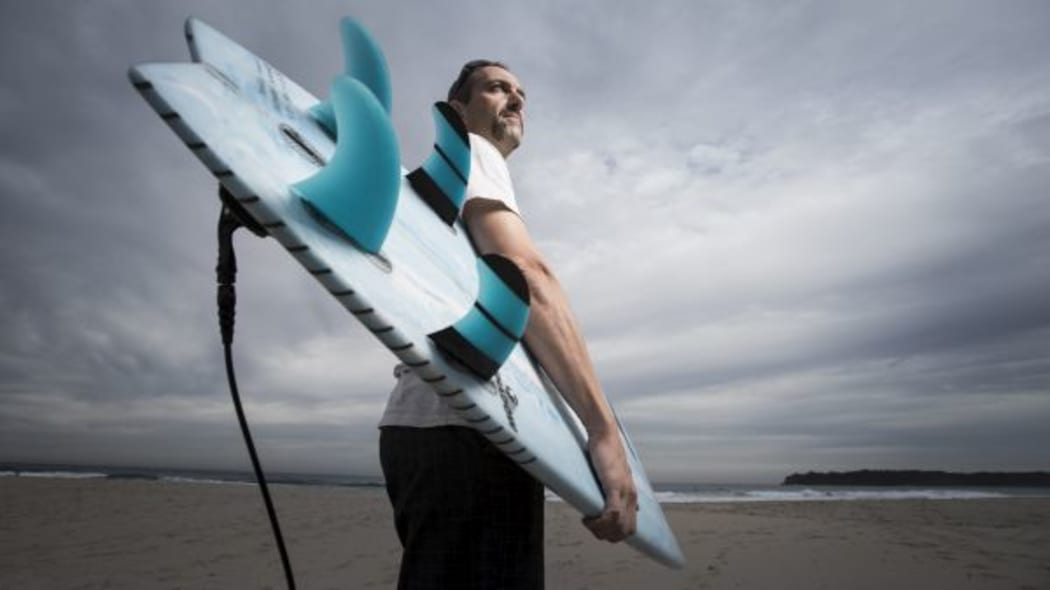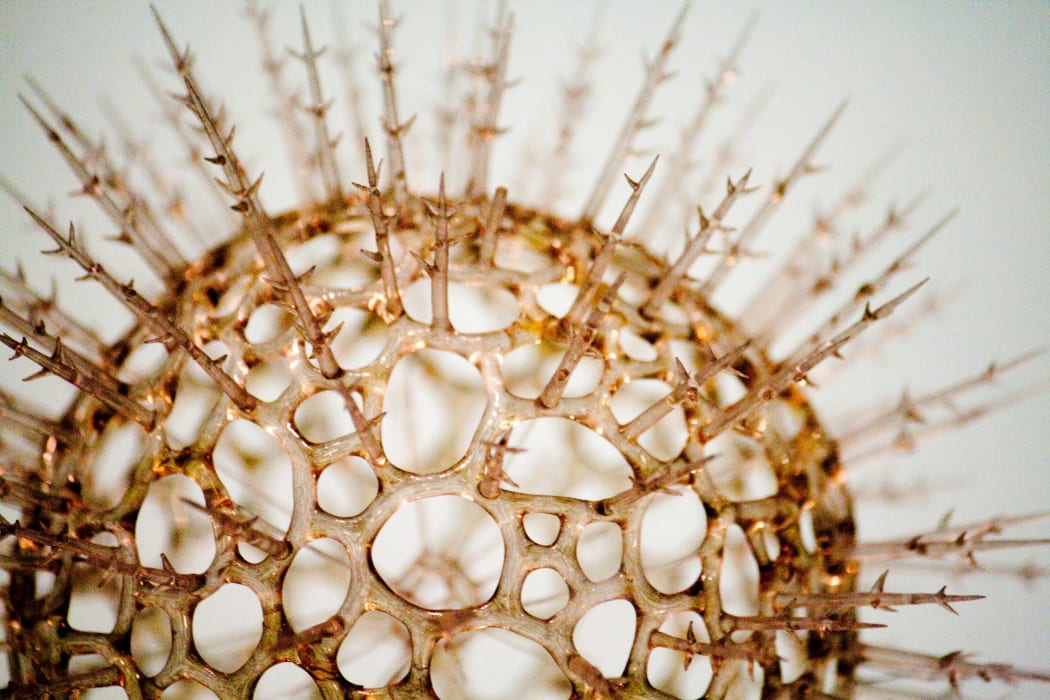This Way Up for Saturday 15 July 2017
This Way Up for Saturday 15 July 2017
Finding new antibiotics, seaweed diet, how 3D printing can transform surfing, anti virus software, and the best way to wash your hands.
Swab and Send: discovering new antibiotics
Antibiotic resistance is a major threat to public health worldwide, and microbiologist Adam Roberts is one of the scientists getting creative on the hunt for the next penicillin.
He's leading the Swab and Send project, which is collecting swabs from the grubby surfaces of everyday life.

Swab and Send Photo: (Facebook)
Almost one million people die around the world every year from infections that cannot be treated with antibiotics, and there are fears this total could reach 10 million a year by 2050 if we don't do something about it soon.
As the World Health Organisation recognised back in 2014, antibiotic resistance is a major threat to public health with potentially devastating consequences.
Finding new drugs that work is one solution, but the pipeline for new antibiotics is looking decidedly sparse, meaning that scientists are having to adopt more creative approaches as they hunt for the next penicillin.
As well as looking at the bottom of the world's oceans and hunting elsewhere in nature, they are also inviting the public to take swabs from the darkest, dirtiest corners of their lives and send them in for analysis. It's an acknowledgment that the next new antibiotic is more likely to come from a grubby keyboard, or a dirty toilet seat than from a shiny lab.
Seaweed: can it boost health?
Pia Winberg sees a future for seaweed far beyond wrapping our sushi.

Photo: via Medlicker.com
The Australian seaweed scientist and entrepreneur is aiming for a world where its health benefits are accepted and the red, brown and green marine algae appears on dinner plates across the globe as a mainstream, everyday food and source of fibre.
Pia's got a 20-year history with seaweed, first in aquaculture and attempts to grow it more sustainably. But a decade ago she got more interested in seaweed as a food: what it contained, its nutritional qualities, and what it could add to our increasingly processed Western diet.
Now she's studying seaweed almost as medicine, with one clinical trial finished and a new one about to start. She is trying to show how seaweed could help people suffering from metabolic disorders, pre-diabetes and skin diseases.
How 3D printing can transform surfing
Serious surfers are prepared to spend up large on boards, wetsuits, and living the surfing lifestyle. It's a massive global business estimated to be worth close to NZ$10 billion annually.

Marc in het Panhuis Photo: (Paul Jones)
Professor Marc in het Panhuis of the University of Wollongong in Australia is a materials scientist and a keen surfer.
He thinks 3D printing could transform surfing, and foresees a world where local surf shops have 3D printers that can quickly and cheaply customise your board while you wait.
Read Marc in het Panhuis's article below.
Surfing the 3D printing wave: the changing face of surfboard fin production

To catch a sweet ride, surfers rely heavily on two things: the waves, and their board.
Surfers can order surfboards that are customised to their needs, or choose from a range of pre-made boards, with little difference in cost. When it comes to surfboard fins, however, it’s a different story.
Fins are aerodynamic foils that act like rudders while surfing, usually attached to the rear bottom of the surfboard. Fins were once permanently glassed into the board, but these days almost all boards have a removable fin system.
Manufacturers of removable fin systems make exceptional products, but the current manufacturing process involves injection moulding, which is very expensive. This pushes it out of economic reach for most surfers looking for a customised fin.
Enter three dimensional (3D) printing. We have developed, designed and 3D printed surfboard fins made from composite materials, and have built and trialled prototype fins with flexibility similar to those available in shops.
3D printed surfing fins
3D printing (or additive manufacturing) refers to a range of manufacturing technologies using computer-aided design and layer-by-layer, bottom-up construction.

Bypassing the need for conventional technologies – such as milling, turning or moulding – it’s perfect for rapid prototyping and fabrication of custom-designed products. 3D printing is ideal for building surfing fins.
Although using 3D printing to make fins is relatively new, there are several examples available on the internet. Most of these have been produced on FDM (Fused Deposition Modelling) printers.
The market for fins
Fins never used to be disposable, at least not for most recreational surfers. These days, however, almost every surfboard (either custom made or bought from a shop) is sold without fins. The fins have become a separate commodity that surfers add to their surfboard. Many surfers use different fins on the same board depending on the wave conditions, such as stiffer fins for larger waves.

The surf retail scene has changed accordingly. Shops have sprung up that are now entirely dedicated to just selling fins.
Fin prices vary depending on the type of surfboard. High-end single fins for longboards and stand-up paddle boards retail for up to AU$150. For shortboards fitted with a thruster (three fin) configuration, prices vary between AU$50 and AU$180.
Surfers wanting the option of surfing their board in either thruster or quad (four fin) configurations can pay as much as AU$270 for a complimentary set of five fins.
Data on fin sales are not easy to find, but the annual revenue for the entire surfing industry is estimated at US$ 7.3 billion. And given that the number of Australians who surf is at least 750,000, the Australian market for fins is around A$75 million per year (based on the conservative assumption that every year each Australian surfer buys at least one set of fins, worth A$100).

Traditional fin production
Mass produced fins all use some sort of moulding process that involves injecting resin in combination with materials such as fibreglass.
Other options include using a honeycomb or hexagonal core that is incorporated in the moulding process. This can be further modified by strategically placing a skin of carbon, Kevlar or aluminium-coated fibreglass (texalium) on the fin during production. Commercial fins are usually composite materials.
3D printed fins have been made using a wide range of thermoplastic polymers, such as ABS (Acrylonitrile Butadiene Styrene) and PLA (PolyLactic Acid).
However, the key is to use materials that offer the required material characteristics, such as stiffness or flexibility. We have found that composite, or mixed materials are required to produce 3D printed fins with similar flex properties to that found in commercial fins.

What surfers look for in fins
Fins in surfboards enable surfers to control the direction that their surfboard travels.
The physics of this takes time to explain, but it essentially comes down to this: surfers look for a surfboard and fin combination that enables them to execute manoeuvres with speed, power and/or flow depending on their skill level.
3D printing allows a surfer to tailor-make a fin suited to their particular style of surfing. Just like paying for a set of golf clubs fitted to your size and skill level, 3D printing enables the fitting of fins to your surfboard, height, weight, ability and style.
In addition, surfers are thinking more and more about sustainable solutions for the surfing industry. 3D printers can easily incorporate recycled materials to print new fins.
Ready-made vs custom-built
There are surfers who like to buy ready-made boards, and those who order custom boards from shapers. With fins, this is likely to be similar.
3D printed fins are for those surfers who like to control all aspects of their surfing equipment, and will suit those who feel it is important to have fins made to their exact specification.
3D printed fins also offer advantages for developing personalised fins for surf therapy and adaptive (disabled) surfer programs, depending on the needs of the surfer. Personalised fins will allow for better stability, control and steering thereby enhancing the surfing experience.
3D printing may even change surfboard construction. Recently, three-time world surfing champion Mick Fanning rode waves using a 3D-printed surfboard. While most of us won’t achieve the lofty heights of Australia’s champion professional surfer, there may soon be a day when every surfer will be able to insert custom made 3D printed fins into a board, and take to the waves.
![]() Lead author Marc in het Panhuis gets up every day before sunrise, and heads to the ocean for a surf.
Lead author Marc in het Panhuis gets up every day before sunrise, and heads to the ocean for a surf.
Marc in het Panhuis, Professor of Materials Science, University of Wollongong; Andrew Warren, Economic Geography, University of Wollongong; Buyung Kosasih, Associate professor, University of Wollongong; Chris Gibson, Director, UOW Global Challenges Program & Professor of Human Geography, University of Wollongong; Dr Stephen Beirne, Senior research fellow, University of Wollongong, and Julie Steele, Professor, University of Wollongong
This article was originally published on The Conversation.
Anti-virus: could computers kill real life viruses?
We know that computers can defeat virtual viruses with antivirus software, but could they also be used to kill the viruses that affect our bodies?
Scientists are digitising our immune system so they can quickly design custom-made antiviral proteins that shut down deadly and rapidly evolving diseases like influenza and HIV.
Ian Haydon is a biochemist at the University of Washington where this research is being done, and we ask him how far away this approach is from yielding drugs we can use to treat people.
Read Ian Haydon's article below.
Designing antiviral proteins via computer could help halt the next pandemic

Ian Haydon, University of Washington
As Bill Gates sees it, there are three main threats to our species: nuclear war, climate change and the next global pandemic.
Speaking on pandemic preparedness at the Munich Security Conference earlier this year, Gates reminded us that “the fact that a deadly global pandemic has not occurred in recent history shouldn’t be mistaken for evidence that a deadly pandemic will not occur in the future.”
If we want to be prepared for the worst, Gates says, “first and most importantly, we have to build an arsenal of new weapons – vaccines, drugs and diagnostics.”
Some scientists are now using computers to do just that.
Going beyond the immune system
Despite the availability of the flu shot, the World Health Organization reports that seasonal influenza is still responsible for millions of serious illnesses and as many as half a million deaths per year globally. The partial efficacy of each year’s flu shot, coupled with long manufacturing times and limited global availability, suggests new flu-fighting methods are still needed.
And that’s just for the seasonal flu. Pandemic influenza, like the devastating 1918 Spanish flu, could again kill tens of millions of people in a single year.
Antibodies, a natural part of the immune system, are front-line soldiers in the war against viruses. The job of an antibody is to recognize and physically adhere to a foreign invader like influenza. Human antibodies are bivalent, meaning they have two hands with which they can grab onto their target.

Under a microscope, influenza looks like a tiny ball with spikes. It uses some of its surface spikes to break into human cells. By grabbing tightly to those spikes using one or both hands, antibodies can prevent flu particles from infecting human cells. But every year the rapidly evolving influenza picks up mutations in its spike proteins, causing the sticky hands of our antibodies to no longer recognize the virus.
Researchers have long sought a universal flu vaccine – one that doesn’t need to be readministered every year. Efforts to produce one tend to involve injecting noninfectious flu lookalikes in hopes that it will prime the immune system to mount a proper attack on whatever real strain of flu it sees next. Despite some progress, researchers have not yet been able to coax the immune system to defend against all strains of influenza, and the threat of a global pandemic still looms.

Software to beat the flu
Computational protein design offers another way. Rather than relying on the immune system to generate an antibody protein capable of shutting down a virus like the flu, computer modeling can now help quickly create custom antiviral proteins programmed to shut down a deadly virus.
Unlike a vaccine, this class of drug could be administered to treat an existing infection or given days prior to exposure to prevent one. And because these designer proteins work independently of the immune system, their potency does not depend on having an intact immune system – a useful trait, as those with weaker immune systems are at high risk for viral infection.
Computer-generated antiviral proteins work the same way some natural proteins in our immune system do. By having surfaces that are chemically complementary to their targets, antiviral proteins can stick tightly to a specific virus. If a protein sticks to a virus in just the right way, it can physically block how that virus moves, ultimately preventing infection.
By designing an antiviral protein on a computer, building it in the laboratory and then administering it into the body, you effectively digitize part of the immune system.
In 2016, computer-generated proteins were shown to be more effective than oseltamivir (Tamiflu) in warding off death in influenza-infected mice. One dose of designer protein given intranasally was more effective than 10 doses of Tamiflu, a drug considered an “essential medicine” by the WHO due to its antiflu activity. What’s more, these new computer-generated antiflu proteins protected mice against diverse strains of the flu. Efforts to turn these promising results into FDA-approved drugs are underway.
In a just published paper in Nature Biotechnology, scientists here at the Institute for Protein Design at the University of Washington went a step further and demonstrated a new way to shut down the flu: They used computer modeling to build a completely new kind of antiviral protein with three sticky hands.
Why three? It turns out many deadly envelope viruses – like influenza, Ebola and HIV – build their spike proteins out of three symmetric parts.
A single antiviral drug with three properly spaced hands should be able to symmetrically grab each part of a spike protein, leading to tighter binding and overall better antiviral activity. This geometric feat is beyond what the human immune system can naturally do.

The design strategy worked. The best three-handed protein, called Tri-HSB.1C, was able to bind tightly to diverse strains of influenza. When given to mice, it also afforded complete protection against a lethal flu infection with only minimal associated weight loss – a trait commonly used to diagnose flu severity in mice. Researchers are now applying the same tools to the Ebola spike protein.
It will be many years before this new technology is approved for use in humans, for any virus. But we may not have to wait long to see some lifesaving benefits.
Viral diagnostics
By coating a strip of paper with a three-handed flu binder and applying influenza samples on top, the same team was able to detect the presence of viral surface protein even at very low concentrations. This proof-of-concept detection system could be transformed into a reliable and affordable on-site diagnostic tool for a variety of viruses by detecting them in saliva or blood. Like a pregnancy test, a band on a test strip could indicate flu. Or Ebola. Or the next rapidly spreading global pandemic.
In a 2015 letter to the New England Journal of Medicine on lessons learned from the Ebola epidemic in West Africa, Bill Gates describes the lack of preparation by the global community as “a global failure.”
“Perhaps the only good news from the tragic Ebola epidemic,” Gates says, “is that it may serve as a wake-up call.” (The Bill and Melinda Gates Foundation funds work on protein design at the University of Washington.)
![]() When a global viral pandemic like the 1918 Spanish flu strikes again, antivirus software of the biological kind may play an important role in saving millions of lives.
When a global viral pandemic like the 1918 Spanish flu strikes again, antivirus software of the biological kind may play an important role in saving millions of lives.
Ian Haydon, Doctoral Student in Biochemistry, University of Washington
This article was originally published on The Conversation. Read the original article.
The best way to wash your hands
Don't bother turning on the hot tap next time you wash your hands. Water at 15 degrees or 38 degrees seems to do just about the same job.
New Zealand's Ministry of Health, like many other health organisations worldwide, advises people that warm water is best for handwashing if it's available.
But researchers have shown that washing your hands in cold water will get them just as clean; it removes similar amounts of bacteria and will also save on power bills.

